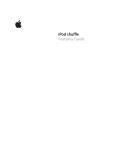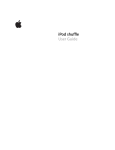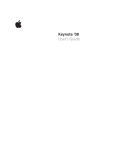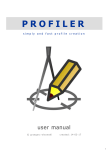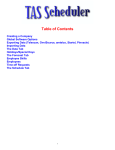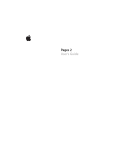Download Apple iPod shuffle User`s guide
Transcript
border.book Page 1 Tuesday, December 21, 2004 10:29 AM iPod shuffle User’s Guide border.book Page 2 Tuesday, December 21, 2004 10:29 AM Contents 3 4 6 Quick Start What You Need to Get Started Four Steps to Playing Music on iPod shuffle 9 9 10 14 Transferring and Playing Music Using iTunes to Organize Music on Your Computer Transferring Music to iPod shuffle Using the iPod shuffle Controls 16 Charging the Battery 18 Storing Files on iPod shuffle 20 iPod shuffle Accessories 22 Tips and Troubleshooting 26 Learning More, Service, and Support 27 Safety and Cleaning 2 border.book Page 3 Tuesday, December 21, 2004 10:29 AM 1 Quick Start Congratulations on purchasing your iPod shuffle. Read this section to get started using iPod shuffle quickly. iPod shuffle works with your computer. Import songs from your CD collection or from the iTunes Music Store (available in some countries only) to your computer, then connect iPod shuffle to transfer a selection of songs for listening on the go. 3 border.book Page 4 Tuesday, December 21, 2004 10:29 AM What You Need to Get Started To use iPod shuffle with a Macintosh, you must have: • A Macintosh with built-in USB To charge iPod shuffle, connect it to a high-power USB port. For fast transfer speeds, connect it to a USB 2.0 port. • Mac OS X v10.2.8, Mac OS X v10.3.4 or later To use low-power USB ports, you must have Mac OS X v10.3.6 or later • iTunes 4.7.1 or later (iTunes is included on the iPod CD) To be sure you have the latest version of iTunes, go to www.apple.com/itunes. • iPod software (included on the iPod CD) To use iPod shuffle with a Windows PC, you must have: • A Windows PC with built-in USB or a USB card installed To charge iPod shuffle, connect it to a high-power USB port. For fast transfer speeds, connect it to a USB 2.0 port. • Windows 2000 with Service Pack 4 or later, or Windows XP Home or Professional with Service Pack 2 or later • iTunes 4.7.1 or later (iTunes is included on the iPod CD) To be sure you have the latest version of iTunes, go to www.apple.com/itunes. • iPod software (included on the iPod CD) Important: If iPod shuffle is obstructed from fitting into the USB ports on your computer, you can use an iPod shuffle Dock or a USB extension cable. These items are available at www.ipod.com/store. 4 Quick Start border.book Page 5 Tuesday, December 21, 2004 10:29 AM Your iPod shuffle includes the following components: iPod shuffle USB cap Apple Earphones Lanyard Quick Start 5 border.book Page 6 Tuesday, December 21, 2004 10:29 AM Four Steps to Playing Music on iPod shuffle To set up iPod shuffle, you install software from the iPod CD, and import songs from your music CD collection or purchase songs from the iTunes Music Store (available in some countries only). Then you transfer the songs to iPod shuffle for listening on the go. Step 1: Install the Software Insert the iPod CD into your computer and install iTunes and the iPod software. Step 2: Import Music to Your Computer Complete this step if you haven’t already transferred music to your computer. You can import music from your audio CDs, or if you have an Internet connection, you can buy music online and download it to your computer using the iTunes Music Store. You can browse over a million songs and listen to a 30-second preview of any song. To import music to your computer from an audio CD: 1 Insert a CD into your computer. iTunes opens automatically and the CD is selected in the iTunes Source list. 2 Uncheck songs you don’t want to transfer, then click Import. 3 Repeat for any other CDs with songs you’d like to import. To buy music online: 1 Open iTunes and click Music Store in the Source list. 2 Click the Account button and follow the onscreen instructions to set up an account or enter your existing Apple Account or America Online (AOL) account information (this option is available in some countries only). 6 Quick Start border.book Page 7 Tuesday, December 21, 2004 10:29 AM Step 3: Connect iPod shuffle to Charge the Battery and Transfer Music Remove the USB cap from iPod shuffle and connect iPod shuffle to a high-power USB port on your computer. For fastest transfer speeds, connect iPod shuffle to a USB 2.0 port. Insert iPod shuffle into a high-power USB 2.0 port on your computer. Important: If iPod shuffle is obstructed from fitting into the USB ports on your computer, you can use an iPod shuffle Dock or a USB extension cable, available at www.ipod.com/store. Quick Start 7 border.book Page 8 Tuesday, December 21, 2004 10:29 AM To charge the iPod shuffle battery: When iPod shuffle is connected to a high-power USB port on your computer, the battery charges. The battery status light on the back of iPod shuffle (see page 14) is amber when the battery is charging, and green when the battery is fully charged. If you don’t see this light, try connecting iPod shuffle to another USB port. The first time you connect iPod shuffle, leave it connected for about four hours to charge the battery fully. To transfer songs to iPod shuffle: When you connect iPod shuffle to your computer, iTunes opens automatically and transfers a selection of songs to iPod shuffle. When the song transfer is complete, a message in iTunes says “iPod update is complete. Okay to disconnect.” Step 4: Play Music Once you have charged the iPod shuffle battery and transferred songs, you are ready to play music. Disconnect iPod shuffle from your computer and set the switch (on the back of iPod shuffle) to play in order (⁄) or shuffle (¡). Then insert the Apple Earphones, press Play on iPod shuffle, and enjoy! 8 Quick Start border.book Page 9 Tuesday, December 21, 2004 10:29 AM Transferring and Playing Music 1 Read this section to learn about transferring music to iPod shuffle and playing music. Once you get music into your computer (see page 6), you can connect iPod shuffle and set iTunes to transfer music to iPod shuffle the way you like. Then, each time you connect iPod shuffle, iTunes transfers music according to your settings. Using iTunes to Organize Music on Your Computer Using iTunes, you can browse, play, and manage your music on your computer. You can organize music into lists of songs, called playlists. You can set iTunes to transfer music from one of these playlists to iPod shuffle. n To create a playlist in iTunes: In iTunes, click the Add (+) button and type a name for the playlist, then drag songs from the library or another playlist to the new playlist. 9 border.book Page 10 Tuesday, December 21, 2004 10:29 AM Note: iTunes has many other features. You can create CDs that play in standard CD players (if your computer has a CD-recordable drive), create dynamically updated playlists called Smart Playlists, listen to Internet radio, rate songs according to preference, and much more. This guide has information about using iTunes to transfer music to iPod shuffle. For information about using all the other features of iTunes, open iTunes and choose Help > iTunes and Music Store Help. Transferring Music to iPod shuffle You can connect iPod shuffle to any USB port on your computer to transfer songs from iTunes. For much faster transfer speeds, connect iPod shuffle to a USB 2.0 port. You can transfer songs automatically or manually. n n To transfer songs automatically to iPod shuffle: Simply remove the USB cap and connect iPod shuffle to your computer. iTunes opens and transfers music to iPod shuffle according to your settings in iTunes (see page 11). If iPod shuffle is already connected and you have changed settings, click Autofill to choose and transfer new songs according to the new settings. Note: With versions of Mac OS X before Mac OS X v10.3.6, you must use a high-power USB port. n 10 To transfer songs manually to iPod shuffle: Connect iPod shuffle and drag songs to iPod shuffle in the Source list. Transferring and Playing Music border.book Page 11 Tuesday, December 21, 2004 10:29 AM To delete songs manually from iPod shuffle: 1 Connect iPod shuffle and select it in the Source list. 2 Select a song and press the Delete key on your keyboard. To set iTunes to keep iPod shuffle in the Source list when it isn’t connected: You can set iTunes to keep iPod shuffle in the Source list even when you disconnect it. You can change settings or add or delete songs in the iPod shuffle list. The next time you connect iPod shuffle, songs are transferred according to your changes. 1 In iTunes, select iPod shuffle in the Source list and click the Options button. Options button 2 Select “Keep this iPod in the source list.” Setting How iTunes Transfers Music to iPod shuffle You can set iTunes to transfer a selection of songs from your entire music library or from a selected playlist in iTunes. You can set it to choose songs in order or randomly. Connect iPod shuffle to your computer and select iPod shuffle in the iTunes Source list. Then follow the instructions below. n To select the source from which iTunes transfers songs to iPod shuffle: In the “Autofill from” pop-up menu, choose a playlist. To transfer songs from your entire music library, choose Library. Transferring and Playing Music 11 border.book Page 12 Tuesday, December 21, 2004 10:29 AM n To set iTunes to choose a random selection of songs from your selected source: Select “Choose songs randomly.” If this option is not selected, iTunes transfers songs in the order they appear in the selected playlist or Library. n n To set iTunes to choose higher rated songs more often for transfer: Select “Choose higher rated songs more often.” To set iTunes to leave songs you’ve already chosen on iPod shuffle when you click Autofill: Deselect “Replace all songs when Autofilling.” When you click Autofill, songs you’ve already chosen remain and iTunes selects more songs to fill the available space on iPod shuffle. Converting Songs to Save Space on iPod shuffle Songs encoded using formats other than AAC may take up more space. You can set iTunes to convert higher bitrate songs when they transfer, so they’ll take up less space on iPod shuffle. To set iTunes to convert higher bit rate songs to 128 kbps AAC when they transfer: 1 Connect iPod shuffle to your computer. 2 In iTunes, select iPod shuffle in the Source list and click the Options button. Options button 12 Transferring and Playing Music border.book Page 13 Tuesday, December 21, 2004 10:29 AM 3 Select “Convert higher bitrate songs to 128 kbps AAC for this iPod.” Note: If this option is selected, songs encoded in AIFF or Apple Lossless format are converted to 128 kbps when transferred to iPod shuffle (the song files in iTunes aren’t affected). Otherwise, iPod shuffle doesn’t play songs encoded in those formats. Audio File Formats Supported by iPod shuffle • • • • • AAC (M4A, M4B, M4P) (up to 320 Kbps) MP3 (up to 320 Kbps) MP3 Variable Bit Rate (VBR) WAV AA (audible.com spoken word, formats 2, 3, and 4) A song encoded using AAC or MP3 format has near CD-quality sound, but takes up much less space than a song encoded using AIFF or WAV format. When you import music from a CD using iTunes, it is converted to AAC format by default. Using iTunes for Windows, you can convert nonprotected WMA files to AAC or MP3 format. This can be useful if you have a library of music encoded in WMA format. For more information, open iTunes and choose Help > iTunes and Music Store Help. iPod shuffle does not support AIFF, Apple Lossless, MPEG Layer 1, MPEG Layer 2 audio files, WMA, or audible.com format 1. Transferring and Playing Music 13 border.book Page 14 Tuesday, December 21, 2004 10:29 AM Using the iPod shuffle Controls Use the iPod shuffle controls to play and pause songs and change the volume. Use the switch on the back of iPod shuffle to set iPod shuffle to play through songs in order or to shuffle songs. Status light Headphones port Volume Up button Off position Play/Pause button Play in order position Previous/Rewind button Volume Down button Next/Fast-forward button 14 Transferring and Playing Music Shuffle songs position Battery status button/light USB connector border.book Page 15 Tuesday, December 21, 2004 10:29 AM iPod shuffle Controls Set iPod shuffle to play songs in order Set the switch to play in order (⁄). Set iPod shuffle to shuffle songs Set the switch to shuffle (¡). Go to beginning of playlist Press the Play/Pause (’) button three times quickly (within one second). Turn iPod shuffle off Set the switch to Off. Play or pause a song Press the Play/Pause (’) button. When iPod shuffle is paused, the status light blinks green for one minute. Change the volume Press the Volume Up (∂) or Volume Down (D) button. Skip to the next song Press the Next/Fast-forward (‘) button. Start a song over or play the previous song Press the Previous/Rewind (]) button once to start a song over. Press it twice to play the previous song. Fast-forward or rewind a song Press and hold the Next/Fast-forward (‘) or Previous/Rewind (]) button. Disable the iPod shuffle buttons (So you don’t press them accidentally) Press and hold the Play/Pause (’) button for about three seconds. The status light blinks orange three times. Press and hold Play/Pause again to enable the buttons. The status light blinks green. Check the battery level Press the battery status button. See page 17. Transferring and Playing Music 15 border.book Page 16 Tuesday, December 21, 2004 10:29 AM 1 Charging the Battery Read this section to learn about charging the iPod shuffle battery. iPod shuffle has an internal, non-user-replaceable, rechargeable battery. To charge the iPod shuffle battery: Remove the USB cap and connect iPod shuffle to a high-power USB port on your computer. The battery status light on the back of iPod shuffle turns on. The iPod shuffle battery is 80-percent charged in about two hours, and fully charged in about four hours. When the battery is charging, the iPod shuffle status light is amber. When the battery is fully charged, the light is green until you disconnect iPod shuffle. If you don’t see the status light, try another USB port on your computer. Note: If iPod shuffle is being used as a disk (see page 18), the status light blinks amber continuously. Note: Rechargeable batteries have a limited number of charge cycles. Battery life and number of charge cycles vary by use and settings. For more information, go to www.apple.com/batteries. 16 border.book Page 17 Tuesday, December 21, 2004 10:29 AM To check the battery status: Press the battery status button on the back of iPod shuffle. The battery status light indicates the level of charge. Battery status light Battery status button If the battery status light is green when you press the battery status button, iPod shuffle has a good charge. If the light is amber, iPod shuffle is low on charge, and if it’s red, very little charge is left and you should recharge iPod shuffle soon. If no light is visible, the battery is out of power and you must recharge iPod shuffle to use it. Charging the Battery 17 border.book Page 18 Tuesday, December 21, 2004 10:29 AM 1 Storing Files on iPod shuffle Read this section to learn about using iPod shuffle as an external disk. You can store data on iPod shuffle. You can connect iPod shuffle to another computer to transfer the data. To enable using iPod shuffle as a disk: 1 Connect iPod shuffle to your computer. 2 In iTunes, select iPod shuffle in the Source list and click the Options button. Options button 3 Select “Enable disk use.” 4 If you want to reserve a certain amount of space for file storage, use the Storage Allocation slider. Note: To make space for songs, you must delete files from iPod shuffle. 18 border.book Page 19 Tuesday, December 21, 2004 10:29 AM When you use iPod shuffle as a disk, the status light on the front of iPod shuffle blinks orange continuously, and the iPod shuffle disk icon appears on the desktop on the Mac, or as the next available drive letter in Windows Explorer on a Windows PC. Drag files to and from iPod shuffle to copy them. Ejecting iPod shuffle Important: If the iPod shuffle status light is blinking orange, you must eject iPod shuffle before disconnecting it from your computer. If you don’t eject iPod shuffle before disconnecting it, you could damage files on iPod shuffle. n To eject iPod shuffle: Click the Eject (C) button next to iPod shuffle in the iTunes Source list. If you’re using a Mac, you can also eject iPod shuffle by dragging the iPod shuffle icon on the desktop to the Trash. If you’re using a Windows PC, you can eject iPod shuffle by clicking the Safely Remove Hardware icon in the Windows system tray and selecting your iPod shuffle. Preventing iTunes From Opening Automatically If you use iPod shuffle primarily as a disk, you may want to keep iTunes from opening automatically when you connect iPod shuffle to your computer. To prevent iTunes from opening automatically when you connect iPod shuffle: 1 In iTunes, select iPod shuffle in the Source list and click the Options button. 2 Deselect “Open iTunes when this iPod is attached.” Storing Files on iPod shuffle 19 border.book Page 20 Tuesday, December 21, 2004 10:29 AM iPod shuffle Accessories 1 iPod shuffle comes with some accessories, and many others are available for purchase at www.ipod.com/store. Apple Earphones iPod shuffle comes with a pair of high-quality earbud headphones. n To use the earbud headphones: Plug them in to the Headphones port, then place the earbud in your ear as shown. The headphones cord is adjustable. 20 border.book Page 21 Tuesday, December 21, 2004 10:29 AM iPod shuffle Lanyard Remove the USB cap from iPod shuffle. Then attach iPod shuffle firmly to the lanyard. To disconnect iPod shuffle, simply pull it from the lanyard. Snap iPod shuffle into the lanyard. Warning Use caution when carrying iPod shuffle using the lanyard. Certain activities may pose a risk of injury, especially if the lanyard becomes caught or trapped—for example, while running, cycling, or working around machinery. Available Accessories To purchase iPod shuffle accessories, go to www.ipod.com/store. Available accessories include: • iPod shuffle Dock • iPod shuffle Armband • iPod USB Power Adapter • Additional accessories such as speakers, headsets, car stereo adapters, and more iPod shuffle Accessories 21 border.book Page 22 Tuesday, December 21, 2004 10:29 AM 1 Tips and Troubleshooting Most problems with iPod shuffle can be solved quickly by following the advice in this chapter. If Your iPod shuffle Won’t Turn On or Respond • If the status light blinks orange when you press a button, iPod shuffle’s buttons are disabled. Press and hold the Play/Pause (’) button for about three seconds, until the status light blinks green. • If that doesn’t work, connect iPod shuffle to a high-power USB port on your computer. Your iPod shuffle battery may need to be recharged. • Turn iPod shuffle off, wait five seconds, then turn it on again. • If that doesn’t work, you may need to restore iPod shuffle software. See “iPod shuffle Software Update and Restore” on page 24. If Your iPod shuffle Isn’t Playing Music • Make sure the headphones connector is pushed in all the way. • Make sure the volume is adjusted properly. • If that doesn’t work, press the Play/Pause (’) button. Your iPod shuffle may be paused. 22 border.book Page 23 Tuesday, December 21, 2004 10:29 AM If You Connect iPod shuffle to Your Computer and Nothing Happens • Connect iPod shuffle to a high-power USB port on your computer. It may need to be recharged. Note: With versions of Mac OS X before Mac OS X v10.3.6, you can use iPod shuffle only with high-power USB ports. • Make sure iPod shuffle is connected firmly to your computer. Be sure the connector is oriented correctly. It can only be inserted one way. • Turn iPod shuffle off, wait five seconds, then turn it on again. • Make sure you have installed the software from the iPod CD. • Make sure you have the required computer and software. See “What You Need to Get Started” on page 4. • If that doesn’t work, you may need to restore iPod shuffle software. See “iPod shuffle Software Update and Restore” below. If iPod shuffle Is Obstructed From Fitting Into the USB Port • You can connect using an iPod shuffle Dock or a USB extension cable, available at www.ipod.com/store. If Songs Transfer Slowly • Connect iPod shuffle to a USB 2.0 port on your computer for fast transfer speeds. USB 2.0 transfers songs and data much faster than USB 1.1. Tips and Troubleshooting 23 border.book Page 24 Tuesday, December 21, 2004 10:29 AM iPod shuffle Software Update and Restore Apple periodically updates iPod shuffle software to improve performance or add features. It is recommended that you update your iPod shuffle to use the latest software. You can choose either to update or to restore the iPod shuffle software. • If you choose to update, the software is updated, but your settings and songs are not affected. • If you choose to restore, all songs and data are erased from your iPod shuffle. All iPod shuffle settings are restored to their original state. To update or restore iPod shuffle with the latest software: 1 Go to www.apple.com/support/ipod and download the latest iPod Update. The update has the latest software for all models of iPod. 2 Double-click the software install file and follow the onscreen instructions to install the iPod shuffle Update. 3 Connect iPod shuffle to your computer and open iTunes. The iPod Updater application opens. If you’re using a Windows PC and the iPod Updater application doesn’t open automatically, you can find the updater by choosing Start > All Programs > iPod. 4 Follow the onscreen instructions to update or restore iPod shuffle software. If you use the iPod Updater application and it doesn’t see that iPod shuffle is connected to your computer, turn iPod shuffle off and turn it on again. 24 Tips and Troubleshooting border.book Page 25 Tuesday, December 21, 2004 10:29 AM If you want to restore iPod shuffle software and you don’t have an Internet connection, you can use the iPod Updater application that was installed on your computer when you installed the software from the iPod CD. To restore iPod shuffle software using the iPod Updater application that came on your iPod CD: • If you have a Mac, you can find the iPod Updater application in Applications/Utilities/ iPod Software. • If you have a Windows PC, you can find the iPod Updater application by choosing Start > All Programs > iPod. Tips and Troubleshooting 25 border.book Page 26 Tuesday, December 21, 2004 10:29 AM 1 Learning More, Service, and Support There is more information about using iPod shuffle in onscreen help and on the web. Onscreen Help To learn more about using iTunes, open iTunes and choose Help > iTunes and Music Store Help. Online Resources For the latest information on iPod shuffle, go to www.apple.com/ipod. For an online iPod shuffle tutorial, iPod shuffle service and support information, and the latest Apple software downloads, go to www.apple.com/support/ipod. To register iPod shuffle, go to www.apple.com/register. Obtaining Warranty Service If the product appears to be damaged or does not function properly, go to www.apple.com/support for instructions on how to obtain warranty service. Finding the Serial Number of Your iPod shuffle The serial number is printed on the back of your iPod shuffle, near the USB connector. 26 border.book Page 27 Tuesday, December 21, 2004 10:29 AM 1 Safety and Cleaning Read on to learn about using iPod shuffle safely and cleaning iPod shuffle. Cleaning Follow these general rules when cleaning the outside of your iPod shuffle and its components: • Make sure your iPod shuffle is unplugged. • Use a damp, soft, lint-free cloth. Avoid getting moisture in openings. • Don’t use aerosol sprays, solvents, alcohol, or abrasives. About Handling Your iPod shuffle may be damaged by improper storage or handling. Be careful not to drop your iPod shuffle when playing or transporting the device. Put the USB cap on iPod shuffle when it isn’t connected to your computer. 27 border.book Page 28 Tuesday, December 21, 2004 10:29 AM Important Safety Instructions When setting up and using your iPod shuffle, remember the following: • Follow all instructions and warnings dealing with your iPod shuffle. • Keep these instructions handy for reference by you and others. Warning Electrical equipment may be hazardous if misused. Operation of this product, or similar products, must always be supervised by an adult. Do not allow children access to the interior of any electrical product and do not permit them to handle any cables. Connectors and Ports Never force a connector into a port. If the connector and port do not join with reasonable ease, they probably don’t match. Make sure that the connector matches the port and that you have positioned the connector correctly in relation to the port. Do Not Use Headphones While Driving Important: Use of headphones while operating a vehicle is not recommended and is illegal in some areas. Be careful and attentive while driving. Stop listening to your iPod shuffle if you find it disruptive or distracting while operating any type of vehicle or performing any other activity that requires your full attention. Warning Permanent hearing loss may occur if earbuds or headphones are used at high volume. You can adapt over time to a higher volume of sound, which may sound normal but can be damaging to your hearing. Set your iPod shuffle volume to a safe level before that happens. If you experience ringing in your ears, reduce the volume or discontinue use of your iPod shuffle. 28 Safety and Cleaning border.book Page 29 Tuesday, December 21, 2004 10:29 AM About Operating and Storage Temperatures • Operate your iPod shuffle in a place where the temperature is always between 0º and 35º C (32º to 95º F). • Store your iPod shuffle in a place where the temperature is always between –20º and 45º C (–4º to 113º F). Don’t leave iPod shuffle in your car, since temperatures in parked cars can exceed this range. • iPod shuffle play time may temporarily shorten in low-temperature conditions. Avoid Wet Locations Warning To reduce the chance of shock or injury, do not use your iPod shuffle in or near water or wet locations. • Keep your iPod shuffle away from sources of liquids, such as drinks, washbasins, bathtubs, shower stalls, rain and so on. In case of a spill, you may have to send your equipment to Apple for service. See “Learning More, Service, and Support” on page 26. Do Not Make Repairs Yourself Warning Do not attempt to open your iPod shuffle, disassemble it, or remove the battery. You run the risk of electric shock and voiding the limited warranty. No userserviceable parts are inside. For service, see “Learning More, Service, and Support” on page 26. Safety and Cleaning 29 border.book Page 30 Tuesday, December 21, 2004 10:29 AM Communications Regulation Information FCC Compliance Statement This device complies with part 15 of the FCC rules. Operation is subject to the following two conditions: (1) This device may not cause harmful interference, and (2) this device must accept any interference received, including interference that may cause undesired operation. See instructions if interference to radio or television reception is suspected. Radio and Television Interference This computer equipment generates, uses, and can radiate radio-frequency energy. If it is not installed and used properly—that is, in strict accordance with Apple’s instructions—it may cause interference with radio and television reception. This equipment has been tested and found to comply with the limits for a Class B digital device in accordance with the specifications in Part 15 of FCC rules. These specifications are designed to provide reasonable protection against such interference in a residential installation. However, there is no guarantee that interference will not occur in a particular installation. 30 You can determine whether your computer system is causing interference by turning it off. If the interference stops, it was probably caused by the computer or one of the peripheral devices. If your computer system does cause interference to radio or television reception, try to correct the interference by using one or more of the following measures: • Turn the television or radio antenna until the interference stops. • Move the computer to one side or the other of the television or radio. • Move the computer farther away from the television or radio. • Plug the computer in to an outlet that is on a different circuit from the television or radio. (That is, make certain the computer and the television or radio are on circuits controlled by different circuit breakers or fuses.) If necessary, consult an Apple Authorized Service Provider or Apple. See the service and support information that came with your Apple product. Or, consult an experienced radio/ television technician for additional suggestions. border.book Page 31 Tuesday, December 21, 2004 10:29 AM Important: Changes or modifications to this product not authorized by Apple Computer, Inc. could void the EMC compliance and negate your authority to operate the product. This product was tested for EMC compliance under conditions that included the use of Apple peripheral devices and Apple shielded cables and connectors between system components. It is important that you use Apple peripheral devices and shielded cables and connectors between system components to reduce the possibility of causing interference to radios, television sets, and other electronic devices. You can obtain Apple peripheral devices and the proper shielded cables and connectors through an Apple Authorized Reseller. For non-Apple peripheral devices, contact the manufacturer or dealer for assistance. Responsible party (contact for FCC matters only): Apple Computer, Inc. Product Compliance, 1 Infinite Loop M/S 26-A, Cupertino, CA 95014-2084, 408-974-2000. Industry Canada Statement This Class B device meets all requirements of the Canadian interference-causing equipment regulations. Cet appareil numérique de la classe B respecte toutes les exigences du Règlement sur le matériel brouilleur du Canada. VCCI Class B Statement Electrical Rating 5V DC, 1 A maximum Battery Your iPod shuffle contains a battery. If you have problems with battery life, be sure to update iPod shuffle with the latest software. If you still have problems, go to www.apple.com/support/ ipod for more information. Dispose of iPod shuffle according to your local environmental laws and guidelines. Taiwan: Nederlands: Gebruikte batterijen kunnen worden ingeleverd bij de chemokar of in een speciale batterijcontainer voor klein chemisch afval (kca) worden gedeponeerd. 31 border.book Page 32 Tuesday, December 21, 2004 10:29 AM European Community Complies with European Directives 72/23/EEC and 89/336/EEC. © 2005 Apple Computer, Inc. All rights reserved. Apple, the Apple logo, iPod, iTunes, Mac, Macintosh, and Mac OS are trademarks of Apple Computer, Inc., registered in the U.S. and other countries. Finder is a trademark of Apple Computer, Inc. Apple and the Environment At Apple, we recognize our responsibility to minimize the environmental impacts of our operations and products. For more information, go to www.apple.com/environment/summary.html. www.apple.com/ipod www.apple.com/support/ipod 034-3039-A Printed in XXXX Apple Store and iTunes Music Store are service marks of Apple Computer, Inc., registered in the U.S. and other countries.
































